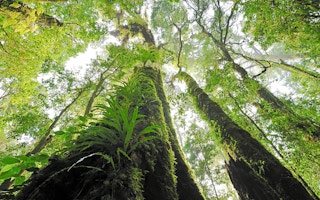An international team of scientists found that species with elevated NSC levels survived up to 17 days longer.
The discovery could help restore forests devastated by logging and increase their resilience to future climate change, they added.
The findings have been published in the journal Nature Climate Change.
“The diversity of tropical trees is staggering but explaining why this diversity arose and how it is maintained is a puzzle,” explained co-author Andrew Hector from the University of Oxford’s Department of Plant Sciences.
“We’ve shown that different species appear to have evolved different levels of drought-busting compounds, which probably play an important role in defining their different ecological niches and which means diverse mixtures of species may be an important insurance against the increasing droughts predicted by climate change models.”
Unlocking secrets
Prof Hector told BBC News that previous studies on plant physiology had indicated that NSCs played a role in a tree’s drought resilience abilities.
“
We’ve shown that different species appear to have evolved different levels of drought-busting compounds, which probably play an important role in defining their different ecological niches and which means diverse mixtures of species may be an important insurance against the increasing droughts predicted by climate change models
Andrew Hector, co-author, University of Oxford’s Department of Plant Sciences
“Why this is the case in not very well known. We set out to test that, but it was a tricky thing to do,” he said.
The team planted 1,400 saplings, made up of 10 different tropical tree species, and divided the young plants into two groups.
The first group was raised initially in dark conditions before being exposed to sunlight. The pattern was reversed for the second group, with the saplings first being grown in sunlight before being placed in dark conditions.
As plants need sunlight to photosynthesise and produce chemicals that feed them, the second group had suppressed NSC levels, allowing the team to compare how this group fared with the first group (with normal NSC levels) when exposed to drought conditions.
The saplings with suppressed NSC levels died more quickly than those with normal levels.
“We now have a characteristic trait - levels of these previously unseen non-structural carbohydrates - that allow us to predict which species and individuals are more vulnerable to drought,” observed co-author Michael O’Brien from the University of Zurich.
The study showed that saplings with suppressed NSC levels dried out (desiccation).
Another member of the team, Sebastian Leuzinger from the Auckland University of Technology, added: “These results also contribute to the hotly debated topic of what exactly kills plants in a drought: whether they actually die of thirst or whether they starve to death.
Prof Hector explained that the findings could have a number of practical uses: “It means we might be able to identify what species within a forest might be at risk in time of drought, but we might be also able to use it for forest restoration.
“If you plant a large area with a species of tree that has low levels of NSC then it suggests that the whole area is potentially vulnerable to droughts,” he suggested.
“Diverse mixture of plants means you are spreading the risk. Although you might lose your vulnerable species, you still have resilient ones in there so the forest maintains its function.”

















